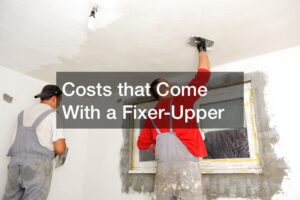
If you’re looking into buying a house to remodel, either to flip or to inhabit, you are going to experience a pretty broad range of expected and unexpected costs. The purchasing price of the home is far from everything that you’re going to spend, unfortunately. Let’s take a few expenses that you can anticipate in this process and a rough estimate on how much each will cost you when remodeling a home.

Many homeowners assume that their roof is essentially invincible and safe from damage for decades. And while a roof is designed to withstand a lot of weather-related troubles and can last for a long time without difficulties, minor to significant issues may quickly develop and cause long-standing problems that may take many repairs. And most of the time, these repairs fall on the person buying a home to remodel.
The average price range for this type of repair will vary depending on the severity of the damage. For instance, Home Guide suggests it can cost about $200 to $800 to repair minor to moderate problems. These issues include everything from a small leak in a single room to missing shingles and even stains on the roof. These costs must be added to your home purchasing price to avoid any complications.
However, you may also find that heavy-duty roof repairs, like the replacement of extensive sections, may cost as much as $1,000 to $3,000. In cases where you have to reshingle the roof or add a new roof entirely, the costs may go even higher. That said, you can usually use this type of extensive damage to argue down the price of the home, so keep that in mind before making a real estate purchase.
Most renovation jobs on a new home will require the use of high-quality construction equipment. For instance, cranes may be needed to work on roofs, various types of destruction machines may be necessary for various kinds of heavy removal, and air hammers and other items provide extra support to different parts of a home. The costs of these machines are usually tied to your renovation fees.
For instance, it may cost construction companies between $40 to $300 per month to lease a piece of equipment. These costs are usually balanced out by creating fees for using specific equipment, such as a $20 to $50 rate for large items. The prices are designed to be covered over several construction jobs, so they won’t charge you the total rate of what they pay every month.
You may also have some fees for equipment maintenance, such as gasoline prices and other costs that help the construction team recoup many of these losses. However, some crews will cover these expenses because they can write them off on their taxes to get back from the government. Talk about these factors with the contractors to ensure you know what to expect before you begin.
In many instances, you may need to contact industrial contractors to inspect and upgrade your home before you finish your remodeling process. These professionals are usually necessary if there are problems with your plumbing or electrical systems. They will come to your house, check for these issues, and upgrade each of these elements as needed to ensure that the house is safe to inhabit.
The costs for these contractors will vary heavily, depending on many factors. For instance, you may spend anywhere between $100 to $350 for small plumbing jobs, such as fixing a few leaky pipes but could pay up to $500 to $800 for more extensive repairs. If you replace almost all of the plumbing, costs could rise into the thousands, depending on the pipes you utilize.
Similar expenses are possible for electrical repairs and upgrades, as well, so make sure to consider this factor in your renovation process. These costs are influenced not just by the prices of the items you need to replace but by the labor costs. In fact, about three-quarters or so of your overall costs here will be for labor, especially if you hire the highest-quality contractors you can find in your area.
Title and Closing
When buying a home, you need to pay for the title and closing costs before starting remodeling. These costs are usually not extensive but do add a little to your price. Sometimes, they must be paid before the home is yours but may also be integrated into the overall purchasing price, depending on your loan and the real estate professional with whom you work.
Typically, the home title will cost several hundred dollars or more to transfer into your name. These costs are centered around the legal fees necessary for this transfer. You may pay more or less, depending on your area and with whom you work. However, you’re likely to spend more on your closing costs, as these can take up around 2-5 percent of the overall purchasing price of a home.
So the more you pay for a home, the more you can anticipate paying for the closing costs. Thankfully, most closing costs are rolled into your loan price, meaning you don’t have to pay it upfront. Unfortunately, this does mean that your interest rate payments on the loan will be higher. Therefore, you may want to pay these closing costs upfront anyway just to avoid excessive fees.

Mold is a widespread problem in many houses, especially those up for sale that needs renovation. This fungal growth occurs anywhere that excessive water or moisture may exist, especially within your basement or attic. However, growths can spread out from these areas into other rooms, such as bedrooms and even entertainment areas. As a result, mold inspection is a critical process.
Testing for this mold can cost anywhere from $300 to $1,000 or more, depending on the severity of this problem. An average cost is about $648, so anticipate about that much just for the test. Removal costs can average at about $650 and range from between $150 to $2,600, again based on the severity of the spread. Some molds may also be more resilient than others and need more extensive removal.
Don’t forget that you may also have to pay replacement costs for your home’s structural elements damaged or stained by mold. For instance, you may have to remove damaged support beams and replace them with new ones, adding to the costs. Anticipate several hundred dollars to up to a thousand or more for this process, depending on your mold problem’s severity and spread.
The cost of buying your new home will vary depending on many various market factors. For instance, the median price of a home is around $340,000 in 2021, though this price is not standard by any means. That’s because many various elements go into valuing a house’s overall worth and cost.
For example, you can find homes at much less this cost that may even be nicer than homes at that price. That’s because the location and other market pressures are often more important than the home’s quality, though the home’s overall structure and size also play into its costs.
A two-story home in a rural area will cost less and be nicer than a one-story ranch home in a densely populated city. And amenities like garages, swimming pools, extra bathrooms, and much more all play into the overall cost of a home. Make sure to balance your needs with your potential renovation costs.

A good alarm system will protect your home and ensure that it is as safe as possible from theft and vandalism. Installing one can cost anywhere between $300 to $1,000 or so, with an average cost of about $700. Prices will go up if your house is large and if you want more extensive elements installed on the home, such as motion-sensor lights around your home’s perimeter.
You also have to consider your monthly fees to these security companies, as many will charge a rate for monitoring your home and keeping it safe from burglary. The costs are anywhere between $50 to $200 per month, again depending on your services’ range and what elements you install on the house. This range of payments means you could spend anywhere between $600 to $2,400 per year.
Glass doors are a ubiquitous element in many homes because they look attractive and provide maximum entry safety levels. Unfortunately, they may end up getting worn down or damaged with time, meaning that you may need to get them replaced before you buy a home. You can anticipate an average cost of between $1,500 to $4,100 for each door you get replaced on a home.
Why are these costs so variable? Lower-end doors utilize less expensive material that is weaker and less attractive. These doors also take less time to install than higher-end doors. So before you start replacing your doors, you may want to seriously consider how much you want to spend. If you have the extra money in your budget, you might as well get the best door that you can afford.
Try to focus on replacing doors that impact the look and style of your home the most. For instance, your front doors should be replaced first because these are what most people will see when driving or walking by your house. The main entry, in particular, needs to be upgraded to keep your home’s doors looking great. From there, you can pick and choose the doors that make the most sense for you to replace.
Keeping your house at a comfortable temperature requires adding an air conditioning system. There are a few different routes you can take here, depending on your finances. For instance, you may want to buy single-window units that you can put in bedrooms or living rooms, as these costs around $250 or so. Portable room-based air conditioners can cost around $700 or so and cool down a whole room with ease.
However, some people may want a full-home air conditioning system, which can cost anywhere between $3,300 to $6,000 on average, with some units costing as much as $10,000 or more. These higher-cost systems are usually needed for larger homes, especially those with multiple stories, as they help get cool air into areas that may require a little more force than usual by using higher-power fans.
You may also want to spend a few thousand dollars or so upgrading your insulation in your home to enhance your overall heating and cooling needs. Better insulation will ensure that your house retains a comfortable temperature more efficiently. Beyond that, it also helps to cut down on your overall costs for heating and cooling bills. Get this step done when renovating your overall home structure.

Potential water damage is a real problem that can influence a broad range of homes and cause extensive issues that require plenty of repairs to manage. You’ll usually see this type of damage in your basement when a pipe bursts. However, roof leaks may also cause extensive damage throughout a home. And floods in an area can trigger devastating damage throughout ground-level regions as well.
Factors that influence this price include the extent of the damage, what cleanup processes are needed, decontamination steps, removal of damaged property, restructuring of your home, the area’s labor costs, and much more. These problems can be quite severe if not correctly managed right away, so you need to make sure that you hire professionals as soon as you notice this type of water damage.
Overall, you can anticipate around $4 per square foot for repairing “clean” water, about $4.50 per square foot for “gray” water, and at least $7 per square foot for black water. Gray and black water contain contaminants such as soaps and chemicals (gray water) and sewage (black water). This type of water is more dangerous to clean and requires more extensive treatment processes. Tie this into replacing drywall and other structural elements, and your prices can skyrocket.



